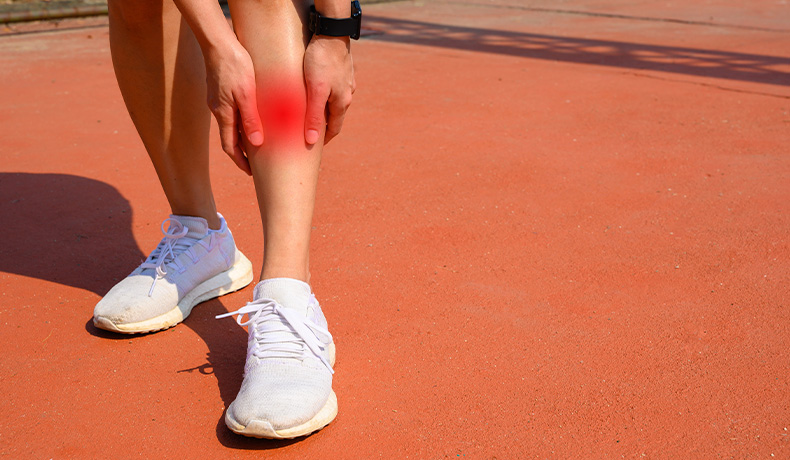
Preventing and Dealing with Shin Splints, Like a Boss
Have you ever felt a sharp pain running down the front of your shin? Especially during or after exercise that involves running, jumping, or repetitive stress on the legs?
Then you might have experienced shin splints.
Medically known as medial tibial stress syndrome (MTSS), shin splints are a common condition characterized by pain in the tibia, the large bone in the front of your lower leg.
And they’re no fun at all.
While shin splints are often associated with athletes, they can actually affect anyone who regularly engages in activities that place a strain on the muscles, bones, and connective tissues of the lower legs.
But What Exactly Are Shin Splints?
Shin splints tend to develop when the muscles, tendons, and bone tissue around the tibia (or shinbone) become overworked. This can lead to tenderness, inflammation, and pain in your lower legs.
There are two main types of shin splints:
Anterior Shin Splints: These occur on the front outside part of the leg along the shinbone and involve the muscles responsible for lifting the foot (dorsiflexion).
Posterior Shin Splints: These affect the inner side of the shinbone and involve the muscles responsible for controlling the arch of the foot.
Both types are often associated with activities that involve a sudden increase in intensity or duration of exercise. However, improper footwear, inadequate stretching, or a poor running technique could also be a responsible cause of shin splints.
Additionally, factors such as flat feet, high arches, and weak stabilizing muscles around the shin can also contribute to the development of shin splints.
How to Prevent Shin Splints
Thankfully, shin splints are largely preventable! It may just involve adopting the correct techniques and habits that minimize the stress placed on the lower legs. Here are some strategies that will help prevent shin splints:
Gradual Progression: Avoid sudden increases in exercise intensity or duration. It’s best to gradually build up both your fitness level and mileage to give your muscles and bones the necessary time to adapt. There’s no rush!
Proper Footwear: Aim for the supportive athletic shoes appropriate for your specific foot type and activity. Ditch those worn-out shoes and replace them with those that maintain proper cushioning and support.
Surface Selection: Opt for softer surfaces such as grass or track whenever possible, especially if you’re prone to shin splints. Avoid running on hard surfaces such as concrete or tile for extended periods.
Stretching and Strengthening: Stretching and strengthening exercises for the calf muscles, Achilles tendon, and ligaments of the lower leg are an excellent way to improve both flexibility and stability. Those who regularly stretch their lower legs have a greatly reduced chance of developing shin splints!
Cross-Training: Engage in low-impact activities such as swimming, cycling, or elliptical training to reduce the repetitive stress on your legs while maintaining your overall cardiovascular fitness. Weight training can also be a great way to boost your fitness levels without all of the nasty impact.
Correct Technique: Always pay attention to your running or exercise technique. Avoid bad habits such as overstriding and heavy stepping, which can increase impact on your legs, and ensure proper alignment and posture during activities.
Warm-Up and Cool Down: Start your workouts with a dynamic warm-up to prepare your muscles and joints for activity, and always finish with a cooldown which includes stretching to help prevent tightness and improve flexibility.
How to Deal with Shin Splints
If you’re already experiencing shin splints, you’re certainly not alone! Around 20% of all people who regularly exercise experience shin splints at some point in their lives. What’s most important is to address and tend to shin splints promptly to prevent them from worsening. Here’s how to deal with shin splints effectively (and like a boss):
Rest: Give your legs the necessary rest that allows the inflammation and pain to subside. Avoid any activities that exacerbate the pain, and consider temporarily switching over to lower-impact exercises.
Ice Therapy: Apply ice packs to the affected area for 15 – 20 minutes several times a day to reduce pain and inflammation. Be sure to wrap the ice pack in a cloth for comfort and to prevent skin damage.
Compression: Use compression sleeves or wraps to provide support and reduce swelling in the affected area. Compression can also help alleviate discomfort and promote healing; just make sure the wrap is snug but not so tight that it impedes blood flow.
Elevation: Put your feet up! Elevate your legs above heart level when resting to encourage drainage of excess fluid and reduce swelling. When laying down, a pillow or a rolled-up towel will do the job.
Pain Management: Over-the-counter pain relievers such as ibuprofen or paracetamol can help alleviate pain and inflammation associated with shin splints. Always follow the recommended dosage, and if the pain persists, consult your GP!
Physical Therapy: If the condition continues for an extended period of time, it may be best to consult a physical therapist. They can provide specific exercises and techniques that strengthen the muscles of the lower leg, while improving flexibility, as well as correct any biomechanical issues that may contribute to shin splints.
Return to Activity Gradually: Once the pain has subsided, don’t rush back into it! Gradually reintroduce activity, starting with low-impact exercises and, over time, steadily increase the intensity and duration.
For nursing a sprain, strain, or tear, be sure to check out our previous article right here!
Like with any injury, it’s always important to first identify its severity. Never hesitate to seek professional medical advice when needed to ensure a safe and effective recovery. By following the preventative steps above, or by dealing with shin splints in the appropriate fashion, there’s no reason why they should affect you long term. Keep pushing forward. Speed bumps and diversions are all a part of the journey, but with the right tools and mindset, there’s no stopping you.
